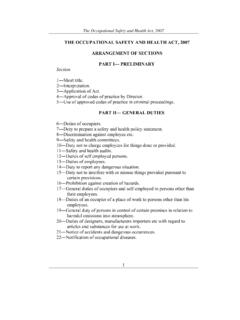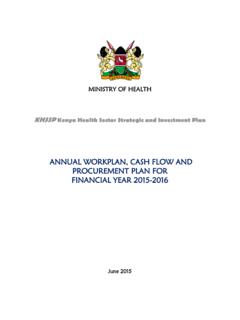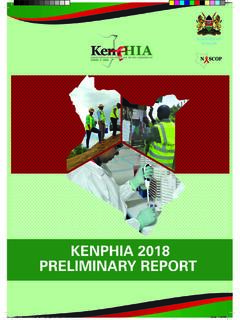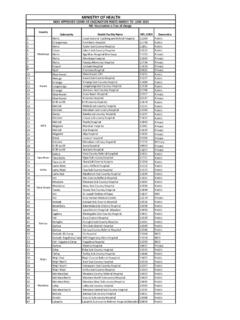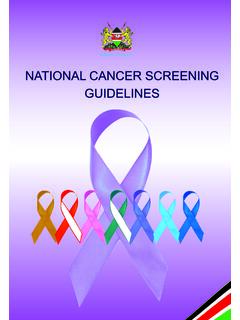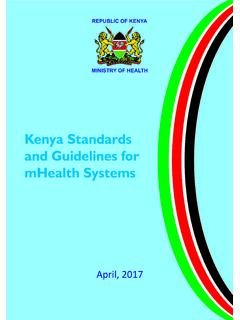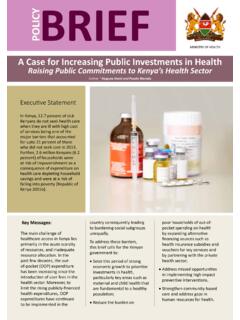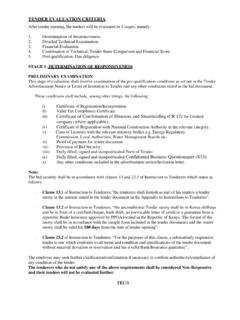Transcription of UHC Policy Brief - MINISTRY OF HEALTH
1 Policy BRIEFR efocusing on quality of care and increasing demand for services; Essential elements in attaining universal HEALTH coverage in Kenyasystems to improve utilization and quality of primary HEALTH care services, by improving access to and demand for these services. Infection control Policy and guidelines for antimicrobial resistance are in place at level 4 and 5 HF Drug Therapeutic Committees (DTC) are functional in most all these modalities, there are quality gaps in terms of inadequate enforcement, and lack of categorization of facilities according to their risk. To mitigate this, Kenya has adopted a national quality assurance framework - the Kenya Quality Model for HEALTH (KQMH), which provides a pathway through which optimal levels of patient safety can be achieved. It also provides a locally driven quality assurance framework on which a regulation and accreditation system can be developed to incentivize facilities to move towards accreditation and total quality management .
2 This will create a level playing field for competition towards the highest attainable standards of quality of care as stipulated in the Constitution. Challenges Inadequate dissemination and enforcement of the implementation of various guidelines Inadequate focus on implementation of the community strategy in particular for example, issues like sanitation (CLTS and ODF), school HEALTH , nutrition, water and general hygiene receive hardly any attention by county managers. Most counties seem to focus more on high cost interventions (Renal unit, ICU etc) than on PHC services. There is an inadequate number of staff at national and county levels in quality assurance and accreditation. Quality is not yet a legal requirement; with poor enforcement, and minimal information on quality of care in private sector. There is inadequate financing to ensure enforcement of quality through inspection and supervision.
3 There is limited reporting and information on the involvement of DPs on quality and quality Revise and strengthen the community strategy to include sanitation and CLTS, de-worming, water and nutrition surveillance and treatment for stunting. Reinforce institutional audits after maternal death. Continue regular and integrated supportive supervision to HEALTH facilities and hospitals Continue with the annual joint monitoring visits to HEALTH facilities using comprehensive guidelines for the visits Reinforce annual exit interviews to assess client satisfaction and perception of services Review the structure of Quality management and employ qualified staff Prioritise quality of care and invest in additional financing for its effective functioning Explore the possibility of making accreditation a semi-autonomous independent agency, separate from the various service delivery OF HEALTHE xecutive StatementKenya has adopted Universal HEALTH Coverage as one of the big four priority agenda by His Excellency the President, with an aspiration that by 2022.
4 All persons in Kenya will be able to use the essential services they need for their HEALTH and wellbeing through a single unified benefit package, without the risk of financial catastrophe. In pursuance of human right to HEALTH , the 58th World HEALTH Assembly of 2005 (WHO, 2005) urged member countries to aim at providing universally accessible HEALTH care to all members of the population based on the principles of equity and solidarity. The human right to HEALTH has been enshrined in Kenya s Constitution 2010 and development agenda outlined in Vision current epidemiological transition from communicable conditions to the triple burden of disease marked by emerging non-communicable conditions and injuries; coupled by efforts by the government to increase access through free maternity and primary healthcare services, has led to an increase in the demand and access to HEALTH services.
5 There have been additional efforts to increase access seen by an increased number of HEALTH facilities providing KEPH services from 41% to 55% between 2013 to 2016, increased staff and equipment through the managed equipment service at all levels, and expansion of maternity wings. Development of a HEALTH financing strategy that will ensure that the entire population is covered with some form of insurance is also underway. Increased access and demand for services, call for deliberate efforts to ensure that the services offered are of high quality. In order to ensure that quality services are offered, Kenya has adopted a national quality assurance framework - the Kenya Quality Model for HEALTH (KQMH), which provides a pathway through which optimal levels of patient safety can be achieved, and introduction of joint HEALTH inspections checklists, which emphasize on risk based ranking of facilities, and enforcement of an appropriate followup action.
6 This will lead to a locally driven quality assurance framework on which a regulation and accreditation system can be developed to incentivize facilities to move towards accreditation and total quality management . This will create a level playing field for competition towards the highest attainable standards of quality of care as stipulated in the because everyone countsGovernment of JapanAuthors: Dr. Wangia Elizabeth, Dr. Kandie CharlesPublished by:The HEALTH Sector Monitoring & Evaluation Unit MINISTRY of HealthKey Message Universal HEALTH coverage (UHC) is the access to safe, effective, quality essential HEALTH care services, including affordable essential medicines and vaccines for all without going into poverty. There have been deliberate efforts to increase access and demand for healthcare services. Emphasis on improving quality of HEALTH services needs to be prioritized in order to achieve UHC.
7 Mechanisms to enforce quality of services need to be institutionalized and legislated at all levelsIntroductionThe constitution of Kenya, under the Bill of Rights, gives the citizens the right to the highest attainable standards of HEALTH in line with the WHO Constitution which declares HEALTH a fundamental human right, thereby committing to ensuring the highest attainable level of HEALTH for all. Universal HEALTH coverage (UHC) has been adopted as Target of the Sustainable Development Goals (SDGs), with a clear goal of ensuring that individuals and communities receive the HEALTH services they need without suffering financial hardship. This includes provision of essential, quality HEALTH services, from HEALTH promotion to prevention, treatment, rehabilitation, and palliative care. Progress towards UHC will ensure progress towards other HEALTH related targets, and towards equity and social inclusion.
8 The Global Burden of Disease ranks Kenya at an approximate UHC index of 50% and predicts that by 2030, Kenya the UHC index will be at 60%. For Kenya to achieve close to 100% UHC, several strategic initiatives have to be put in place to progressively enable everyone to access the services that address the most important causes of disease and death, and ensure that the quality of these services is good enough to improve the HEALTH of efforts have been made to ensure a steady rise towards UHC by designing and implementing HEALTH care Policy reforms, yet a lot more can be done. To increase access and demand for services, initiatives like provision of free PHC services for all; free maternity services at all public HEALTH facilities; HEALTH insurance subsidies for the poor, vulnerable, the old; development of a HEALTH financing strategy that will ensure that the entire population is covered with some form of insurance; increase in staff and equipment through the managed equipment service at all levels, and expansion of maternity wings; have been done.
9 This has resulted in an increase in the number of HEALTH facilities providing KEPH services from 41% to 155% between 2013 to 2016. However, with this increase in demand for services, quality of services is still a major This Policy Brief has been informed by the Mid Term Review Report of the Kenya HEALTH Sector Strategic Plan (KHSSP), together with relevant literature review and studies from relevant programs. It provides recommendations on steps to be taken to fast track the achievement of UHC through improving & ConclusionsFor UHC to be achieved, there is a need for increasing access and quality of healthcare are several opportunities leading to increased demand for HEALTH services. Majority of communities across the country have good HEALTH seeking behavior resulting in increased demand for services. However, there has been continued existence of certain cultural and religious beliefs and practices that threaten demand/access for essential HEALTH services-reduced coverage for essential HEALTH services to needy on the other hand has increased public expectation/demand in terms of service accessibility and quality of services.
10 AccessAccess to HEALTH care services in Kenya is improving but there are still substantial differences within the country with an increased per capita outpatient utilization rate from in 22012/2013 to in 2016. The inpatient admission rate increased steadily during the review period, from in 2012/2013 to in 2016. There has been an increase in facilities that provide high level, specialized care in the counties. To ensure national wide hospital access, the national community HEALTH strategy has been revised and updated. The country has also developed a national referral strategy that provides clear guidelines on referral processes. Other initiatives to increase access include abolishment of user fees at primary level facilities and maternity services and grants with a focus on improving access to quality Primary HEALTH care (PHC) and Reproductive, Maternal, Neonatal, Child and Adolescent HEALTH (RMNCAH) services by supporting operation and maintenance costs of primary HEALTH care slum upgrading project, addresses the social and economic challenges facing slum dwellers to access HEALTH care services, with 11 mobile clinics established and operational.
